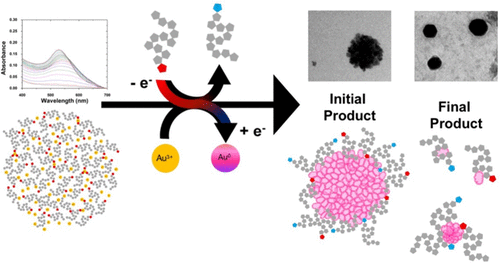Our official English website, www.x-mol.net, welcomes your
feedback! (Note: you will need to create a separate account there.)
Solution Effects on Peptide-Mediated Reduction and Stabilization of Au Nanoparticles
Langmuir ( IF 3.7 ) Pub Date : 2017-11-17 00:00:00 , DOI: 10.1021/acs.langmuir.7b01896 Catherine J. Munro 1 , Marc R. Knecht 1
Langmuir ( IF 3.7 ) Pub Date : 2017-11-17 00:00:00 , DOI: 10.1021/acs.langmuir.7b01896 Catherine J. Munro 1 , Marc R. Knecht 1
Affiliation

|
Biomimetic methods for the preparation and application of inorganic nanomaterials represent a unique avenue to sustainably generating functional materials with long-term activity. Typically, for the fabrication of these structures, the peptide is mixed with metal ions in solution prior to the addition of an exogenous reductant such as NaBH4, leading to nanoparticle nucleation and growth. In biological systems, strong reductants such as NaBH4 are not available, thus different metal ion reduction methods must be exploited. Recent work has shown that the AuBP1 peptide (WAGAKRLVLRRE), a Au binding peptide with an N-terminal tryptophan, can spontaneously reduce Au3+ without an exogenous reductant. Remarkably, this system initially demonstrated the formation of large Au aggregates that disassemble to form individual Au nanoparticles, stabilized by the peptide bound to the inorganic surface. In this contribution, we demonstrate the significant effects of aqueous solvent-processing conditions (pH, ionic strength, and ion composition) on the rate of particle evolution. Understanding how such effects alter the metal ion reduction process and subsequent nanoparticle fabrication is important in controlling the final structure/function relationship of the resultant peptide-capped materials. This work identifies conditions that may enhance nanoparticle synthesis using biomimetic approaches where the peptide has complete control over the complexation, reduction, nucleation, and growth of nanomaterials.
中文翻译:

溶液对金纳米粒子介导的肽还原和稳定作用的影响
用于制备和应用无机纳米材料的仿生方法代表了可持续产生具有长期活性的功能材料的独特途径。通常,为了制造这些结构,在添加外源还原剂(例如NaBH 4)之前,将肽与溶液中的金属离子混合,从而导致纳米颗粒成核和生长。在生物系统中,无法使用强还原剂(如NaBH 4),因此必须采用不同的金属离子还原方法。最近的工作表明,AuBP1肽(WAGAKRLVLRRE)是一种具有N端色氨酸的Au结合肽,可以自发还原Au 3+没有外源还原剂。值得注意的是,该系统最初证明了大的金聚集体的形成,该聚集体分解形成单个的金纳米颗粒,并通过与无机表面结合的肽稳定了。在这一贡献中,我们证明了水性溶剂处理条件(pH,离子强度和离子组成)对颗粒演化速率的显着影响。理解这种影响如何改变金属离子还原过程和随后的纳米粒子制造对于控制所得肽封端材料的最终结构/功能关系很重要。这项工作确定了可以使用仿生方法增强纳米颗粒合成的条件,其中肽具有对纳米材料的络合,还原,成核和生长的完全控制。
更新日期:2017-11-19
中文翻译:

溶液对金纳米粒子介导的肽还原和稳定作用的影响
用于制备和应用无机纳米材料的仿生方法代表了可持续产生具有长期活性的功能材料的独特途径。通常,为了制造这些结构,在添加外源还原剂(例如NaBH 4)之前,将肽与溶液中的金属离子混合,从而导致纳米颗粒成核和生长。在生物系统中,无法使用强还原剂(如NaBH 4),因此必须采用不同的金属离子还原方法。最近的工作表明,AuBP1肽(WAGAKRLVLRRE)是一种具有N端色氨酸的Au结合肽,可以自发还原Au 3+没有外源还原剂。值得注意的是,该系统最初证明了大的金聚集体的形成,该聚集体分解形成单个的金纳米颗粒,并通过与无机表面结合的肽稳定了。在这一贡献中,我们证明了水性溶剂处理条件(pH,离子强度和离子组成)对颗粒演化速率的显着影响。理解这种影响如何改变金属离子还原过程和随后的纳米粒子制造对于控制所得肽封端材料的最终结构/功能关系很重要。这项工作确定了可以使用仿生方法增强纳米颗粒合成的条件,其中肽具有对纳米材料的络合,还原,成核和生长的完全控制。











































 京公网安备 11010802027423号
京公网安备 11010802027423号